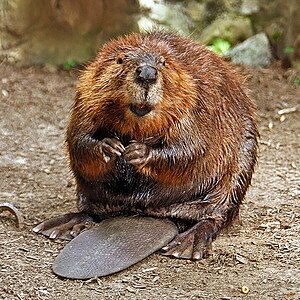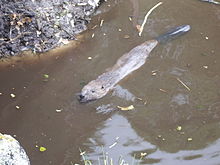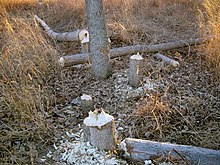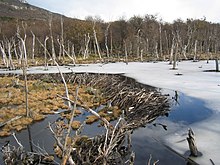Beaver
| Beaver Temporal range: Late Miocene – Recent
| |
|---|---|

| |
| North American Beaver (Castor canadensis) | |
| Scientific classification | |
| Kingdom: | |
| Phylum: | |
| Class: | |
| Order: | |
| Family: | |
| Genus: | Castor Linnaeus, 1758
|
| Species | |
The beaver (genus Castor) is a primarily nocturnal, large, semi-aquatic rodent. Castor includes two extant species, Castor canadensis (native to North America) and Castor fiber (Eurasia). Beavers are known for building dams, canals, and lodges (homes). They are the second-largest rodent in the world (after the capybara). Their colonies create one or more dams to provide still, deep water to protect against predators, and to float food and building material. The North American beaver population was once more than 60 million, but as of 1988 was 6–12 million. This population decline is due to extensive hunting for fur, for glands used as medicine and perfume, and because their harvesting of trees and flooding of waterways may interfere with other land uses.[1]
General

Beavers are known for their natural trait of building dams on rivers and streams, and building their homes (known as "lodges") in the resulting pond. Beavers also build canals to float build materials that are difficult to haul over land. They use powerful front teeth to cut trees and plants that they use for building and for food. In the absence of existing ponds, beavers have to construct dams before building their lodges. First they place vertical poles and then fill between the vertical poles with a crisscross of horizontally placed branches. They fill in the gaps between the branches with a combination of weeds and mud until the dam holds back sufficient water to surround the lodge.
They are known for their alarm signal: when startled or frightened, a swimming beaver will rapidly dive while forcefully slapping the water with its broad tail, audible over great distances above and below water. This noise serves as a warning to beavers in the area. Once a beaver has sounded the alarm, nearby beavers dive and may not reemerge for some time. As a defense mechanism beavers have developed the ability to use their lower mandibles as makeshift weapons. By using the brute force of the jaw bone, similar to a boomerang, they can keep their young safe from predators.[1] Beavers are slow on land, but good swimmers that can stay under water for as long as 15 minutes. (Wilson, 1971) Rarely does a frightened beaver attack a human.[2]
Beavers do not hibernate, but store sticks and logs in a pile in their ponds, eating the underbark. Some of the pile is generally above water and accumulates snow in the winter. This insulation of snow often keeps the water from freezing in and around the food pile, providing a location where beavers can breathe when outside their lodge.
Fossil remains of beavers are found in the peat and other superficial deposits of Britain and the continent of Europe; while in the Pleistocene formations of Britain and Siberia, occur remains of a giant extinct beaver, Trogontherium cuvieri, representing a genus by itself.
Beavers have webbed hind-feet, and a broad, scaly tail. They have poor eyesight, but keen senses of hearing, smell, and touch.
Beavers continue to grow throughout life. Adult specimens weighing over 25 kg (55 lb) are not uncommon. Females are as large as or larger than males of the same age, which is uncommon among mammals. Beavers live up to 24 years of age in the wild.
Etymology
The word is descended from the Proto-Indo-European name of the animal, cf. Sanskrit babhru's, brown, the great ichneumon, Lat. fiber, Ger. Biber, Russ. bobr'; the root bhru has given "brown", and, through Romanic, "bronze" and "burnish".[3]
Species
They are the only extant members of the family Castoridae, which contains a single genus, Castor. Genetic research has shown the European and North American beaver populations to be distinct species and that hybridization is unlikely. Beavers are closely related to squirrels (Sciuridae), agreeing in certain structural peculiarities of the lower jaw and skull. In the Sciuridae the two main bones (tibia and fibula) of the lower half of the leg are quite separate, the tail is round and hairy, and the habitats are arboreal and terrestrial. In the beavers or Castoridae these bones are in close contact at their lower ends, the tail is depressed, expanded and scaly, and their habitats are aquatic.[3]

Although superficially similar to each other, there are several important differences between the two species. European beavers tend to be bigger, with larger, less rounded heads, longer, narrower muzzles, thinner, shorter and lighter underfur, narrower, less oval-shaped tails and shorter shin bones, making them less capable of bipedal locomotion than the North American species. European beavers have longer nasal bones than their North American cousins, with the widest point being at the end of the snout for the fomer, and in the middle for the latter. The nasal opening for the European species is triangular, unlike that of the North American race which is square. The foramen magnum is rounded in the European beaver, and triangular in the North American. The anal glands of the European beaver are larger and thin-walled with a large internal volume compared to that of the North American breed. Finally, the guard hairs of the European beaver have a longer hollow medulla at their tips. Fur colour is also different. Overall, 66% of European beavers have pale brown or beige fur, 20% have reddish brown, nearly 8% are brown and only 4% have blackish coats. In North American beavers,50% have pale brown fur, 25% are reddish brown, 20% are brown and 6% are blackish.[4]
The two species are not genetically compatible. North American beavers have 40 chromosomes, while European beavers have 48. Also, more than 27 attempts were made in Russia to hybridize the two species, with one breeding between a male North American beaver and a female European resulting in one stillborn kit. These factors make interspecific breeding unlikely in areas where the two species' ranges overlap.[4]
European Beaver

The European Beaver (Castor fiber) was hunted almost to extinction in Europe, both for fur and for castoreum, a secretion of its scent gland believed to have medicinal properties. However, the beaver is now being re-introduced throughout Europe. Several thousand live on the Elbe, the Rhone and in parts of Scandinavia. A thriving community lives in northeast Poland, and the European Beaver also returned to the Morava River banks in Slovakia and the Czech Republic. They have been reintroduced in Scotland,[5] Bavaria, Austria, The Netherlands, Serbia (Zasavica bog), Denmark (West Jutland) and Bulgaria and are spreading to new locations. The beaver became extinct in Great Britain in the sixteenth century: Giraldus Cambrensis reported in 1188 (Itinerarium ii.iii) that it was to be found only in the Teifi in Wales and in one river in Scotland, though his observations are clearly second hand. In October 2005, six European beavers were reintroduced to Britain in Lower Mill Estate in Gloucestershire; in July 2007 a colony of four European beavers was established at Martin Mere in Lancashire,[6] and a trial re-introduction occurred in Scotland in May 2009. Feasibility studies for a reintroduction to Wales are at an advanced stage and a preliminary study for a reintroduction of beavers to the wild in England has recently been published.[7][8]
North American Beaver

The North American Beaver (Castor canadensis), also called the Canadian Beaver (which is also the name of a subspecies), American Beaver, or simply Beaver in North America, is native to Canada, much of the United States and parts of northern Mexico. The chief feature distinguishing C. canadensis from C. fiber is the form of the nasal bones of the skull.[3] This species was introduced to the Argentine and Chilean Tierra del Fuego, as well as Finland, France, Poland and Russia.
The North American beaver's preferred food is the water-lily (Nuphar luteum), which bears a resemblance to a cabbage-stalk, and grows at the bottom of lakes and rivers.[9] Beavers also gnaw the bark of birch, poplar, and willow trees; but during the summer a more varied herbage, with the addition of berries, is consumed. These animals are often trapped for their fur. During the early 19th century, trapping eliminated this animal from large portions of its original range. However, through trap and transfer and habitat conservation it made a nearly complete recovery by the 1940s. Beaver reintroduction in British Columbia was facilitated by Eric Collier as recounted in his book Three Against the Wilderness. Beaver furs were used to make clothing and top-hats. Much of the early exploration of North America was driven by the quest for this animal's fur. Native peoples and early settlers also ate this animal's meat. The current beaver population has been estimated to be 10 to 15 million; one estimate claims that there may at one time have been as many as 90 million.[10]
Giant beaver
The North American Giant beaver (Castoroides ohioensis) was one of the largest rodents that ever evolved. With a length up to 2.5 m (8.2 ft) it was about the size of a small American Black Bear. It disappeared along with other large mammals in the Holocene extinction event, which began about 13,000 years ago.
Habitat

The habitat of the beaver is the riparian zone, inclusive of stream bed. The actions of beavers for hundreds of thousands of years in the Northern Hemisphere have kept these watery systems healthy and in good repair, although a human observing all the downed trees might think that the beavers were doing just the opposite.
The beaver works as a keystone species in an ecosystem by creating wetlands that are used by many other species. Next to humans, no other extant animal appears to do more to shape its landscape.[11]
Beavers fell trees for several reasons. They fell large mature trees, usually in strategic locations, to form the basis of a dam, but European beavers tend to use small diameter (<10 cm) trees for this purpose. Beavers fell small trees, especially young second-growth trees, for food. Broadleaved trees re-grow as a coppice, providing easy-to-reach stems and leaves for food in subsequent years. Ponds created by beavers can also kill some tree species by drowning but this creates standing dead wood, which is very important for a wide range of animals and plants.[citation needed]
Dams

Beaver dams are created as a protection against predators, such as coyotes, wolves and bears, and to provide easy access to food during winter. Beavers always work at night and are prolific builders, carrying mud and stones with their fore-paws and timber between their teeth. Because of this, destroying a beaver dam without removing the beavers is difficult, especially if the dam is downstream of an active lodge. Beavers can rebuild such primary dams overnight, though they may not defend secondary dams as vigorously. (Beavers may create a series of dams along a river.)
Lodges

The ponds created by well-maintained dams help isolate the beavers' homes, their lodges, which are created from severed branches and mud. The beavers cover their lodges late every autumn with fresh mud, which freezes when the frost sets in. The mud becomes almost as hard as stone, so that neither wolves nor wolverines can get in.
The lodge has underwater entrances to make entry nearly impossible for any other animal (however, muskrats have been seen living inside beaver lodges with the beavers who made them).[citation needed] A very small amount of the lodge is actually used as a living area. Contrary to popular belief, beavers actually dig out their dens with underwater entrances after they finish building the dams and lodge structures. There are typically two dens within the lodge, one for drying off after exiting the water, and another, drier one where the family actually lives.

Beaver houses are formed of the same materials as the dams, with little order or regularity of structure, and seldom contain more than four adult and six or eight young beavers. Some of the larger houses have one or more partitions, but these are only posts of the main building left by the builders to support the roof, for the apartments usually have no communication with each other except by water.
When the ice breaks up in spring beavers always leave their embankments and rove about until a little before fall, when they return to their old habitations and lay in their winter stock of wood. They seldom begin to repair the houses until the frost sets in, and never finish the outer coating till the cold becomes severe. When they erect a new habitation they fell the wood early in summer, but seldom begin building until nearly the end of August.
Invasiveness

Beavers often modify their natural environment by building dams, and are therefore considered as pests or invasive species in some places. For example, in the 1940s, beavers were brought to the island of Tierra Del Fuego in southern Argentina for commercial fur production. However, the project failed and a few pairs of beavers were released into the wild. They quickly spread throughout the island, reaching a number of 100,000 individuals within just 50 years. As the habitat is not adapted to withstand the impact of beavers (e.g. unlike in the Northern Hemisphere, trees native to Tierra del Fuego do not coppice), beavers have had a detrimental impact. They are now considered a serious invasive species on the island, due to their massive destruction of forest trees, and efforts are being made for their eradication.[12]
Urban beavers
After 200 years, a beaver has returned to New York City, making its home along the Bronx River, having spent time living at the Bronx Zoo as well as the Botanical Gardens.[13] Beavers were trapped to near extirpation and hadn't been seen in New York City since the early 1800s. The return of "Jose", named after representative Jose Serano from the Bronx, is seen as evidence that efforts to restore the river have been successful.[14]
In Chicago, several beavers have returned and made a home near the Lincoln Park Zoo. The "Lincoln Park Beaver" has not been as well received by the Chicago Park District, which has killed one beaver and removed several others using live traps, due to concerns over damage to trees in the area.[15][16][17]
Outside San Francisco, in downtown Martinez, California, a male and female beaver arrived in Alhambra Creek in 2006.[18] The beavers built a dam 30 feet wide and at one time 6 feet high, and chewed through half the willows and other creekside landscaping the city planted as part of its $9.7 million 1999 flood-improvement project. When the City Council wanted to remove the beavers because of fears of flooding, local residents organized to protect them, forming an organization called "Worth a Dam".[19] Resolution included installing a pipe through the beaver dam so that the pond's water level could not become excessive. Now protected, the beaver have transformed Alhambra Creek from a trickle into multiple dams and beaver ponds, which in turn, lead to the return of steelhead trout and river otter in 2008, and mink in 2009.[20][21] The Martinez beavers probably originated from the Sacramento-San Joaquin River Delta which once held the largest concentration of beaver in North America.[22]
Commercial uses

Both beaver testicles and castoreum, a bitter-tasting secretion with a slightly fetid odor contained in the castor sacs of male or female beaver, have been articles of trade for use in traditional medicine. Yupik (Eskimo) medicine used dried beaver testicles like willow bark to relieve pain. Beaver testicles were exported from Levant (a region centered on Israel) from the tenth to nineteenth century.[23] Claudius Aelianus comically described beavers chewing off their testicles to preserve themselves from hunters, which is not possible because the male beaver's testicles are inside its body. European beavers (Castor fiber) were eventually hunted nearly to extinction in part for the production of castoreum, which was used as an analgesic, anti-inflammatory, and antipyretic. Castoreum was described in the 1911 British Pharmaceutical Codex for use in dysmenorrhea and hysterical conditions (i.e. pertaining to the womb), for raising blood pressure and increasing cardiac output. The activity of castoreum has been credited to the accumulation of salicin from willow trees in the beaver's diet, which is transformed to salicylic acid and has an action very similar to aspirin.[24] Castoreum continues to be used in perfume production.
In culture

As a national emblem
The importance of the Beaver in the development of Canada through the fur trade led to its designation as the national animal. It is depicted on the Canadian five-cent piece and was on the first pictorial postage stamp issued in the Canadian colonies in 1849 (the so-called "Three-Penny Beaver"). As a national symbol, the beaver was chosen to be the mascot of the 1976 Summer Olympics held in Montreal with the name "Amik" ("beaver" in Ojibwe). The beaver is also the symbol of many units and organizations within the Canadian Forces, such as on the cap badges of the Royal 22e Régiment and the Canadian Military Engineers. Toronto Police Services, London Police Service, Canadian Pacific Railway Police Service and Canadian Pacific Railway crest bears the beaver on their crest or coat of arms.
Others who have used the beaver in their company or organizational symbol or as their mascot include:
- Beaver Buzz
- Beaver Lumber
- The Beaver (magazine)
- Camp Tamakwa
- California Institute of Technology
- London School of Economics[25]
- Massachusetts Institute of Technology
- The City of New York
- The State of New York
- The State of Oregon
- Oregon State University
- St Anne's College, Oxford
- The University of Toronto
- The University of Alberta Engineering
- Buena Vista University
- Washington State Parks & Recreation Commission
- Wilfrid Laurier University
In dietary law
In the 17th century, based on a question raised by the Bishop of Quebec, the Roman Catholic Church ruled that the beaver was a fish (beaver flesh was a part of the indigenous peoples' diet, prior to the Europeans' arrival) for purposes of dietary law. Therefore, the general prohibition on the consumption of meat on Fridays during Lent does not apply to beaver meat.[26][27][28] The legal basis for the decision probably rests with the Summa Theologica of Thomas Aquinas, which bases animal classification as much on habit as anatomy.[29] This is similar to the Church's classification of the capybara, another semi-aquatic rodent.[30]
Trapping
Beavers have been trapped for millennia, and this continues to this day.[16] Beaver pelts were used for barter by Native Americans in the 17th century to gain European goods. They were then shipped back to Great Britain and France where they were made into clothing items. Widespread hunting and trapping of beavers led to their endangerment. Eventually, the fur trade declined due to decreasing demand in Europe and the takeover of trapping grounds to support the growing agriculture sector. A small resurgence in beaver trapping has occurred in some areas where there is an over-population of beaver; trapping is done when the fur is of value, and the remainder of the animal may be used as feed. In the 1976/1977 season, 500,000 beaver pelts were harvested in North America.[31]
References
- ^ a b Nowak, Ronald M. 1991. pp. 364–367. Walker's Mammals of the World Fifth Edition, vol. I. John Hopkins University Press, Baltimore.
- ^ Matilda, 4, bitten by beaver
- ^ a b c Encyclopædia Britannica, 11th Ed.
- ^ a b Kitchener, Andrew (2001). Beavers. Stowmarket: Whittet. p. 144. ISBN 187358055X.
- ^ "Beavers returning to UK after 400 years".
- ^ "Beavers are back after 500 years". BBC News. 2007-07-11.
- ^ Return of the Beavers at MSN.co.uk
- ^ "Beavers could be released in 2009". BBC. 2007-12-24. Archived from the original on 2008-02-06.
- ^ "The Beaver (Castor canadensis)". 2002. Retrieved 2008-05-19.
- ^ Seton-Thompson, cited in Sun, Lixing (2003). The Beaver: Natural History of a Wetlands Engineer. Cornell University Press. ISBN 080144098X.
{{cite book}}: Unknown parameter|coauthors=ignored (|author=suggested) (help) pp. 97–98; but note that to arrive at this figure he assumed a population density throughout the range equivalent to that in Algonquin Park - ^ Beaver. In Animals. Retrieved June 15, 2009, from http://animals.nationalgeographic.com/animals/mammals/beaver.html (beavers “second only to humans in their ability to manipulate and change their environment”)
- ^ CNN - Argentina eager to rid island of beavers - July 9, 1999
- ^ http://www.sciencedaily.com/releases/2008/12/081218080817.htm
- ^ http://www.nytimes.com/2007/02/23/nyregion/23beaver.html
- ^ Boehm, Kiersten. “Lincoln Park Beaver Relocated” Inside. 14 Nov 2008
- ^ a b http://www.myfoxchicago.com/dpp/news/beaver_north_pond_apr09
- ^ http://chicago.timeout.com/articles/museums-culture/74267/why-are-there-signs-that-claim-the-park-district-murdered-a-beaver
- ^ Carolyn Jones (April 16, 2008). "Moment of truth for Martinez beavers". San Francisco Chronicle.
{{cite web}}:|access-date=requires|url=(help); Check date values in:|accessdate=(help); Missing or empty|url=(help) - ^ "Worth a Dam website".
- ^ Aleta George (2008). "Martinez Beavers". Bay Nature. Bay Nature Institute. Retrieved Nov. 6, 2009.
{{cite web}}: Check date values in:|accessdate=(help) - ^ Nicola DeRobertis-Theye. "Beavers and More in Martinez:New Habitat Thanks to Beavers". Bay Nature. Bay Nature Institute. Retrieved Nov. 6, 2009.
{{cite web}}: Check date values in:|accessdate=(help) - ^ Thomas Jefferson Farnham (1857). Life, adventures, and travels in California. Blakeman & Co. p. 383.
- ^ PMID 12576209
- ^ Stephen Pincock (2005-03-28). "The quest for pain relief: how much have we improved on the past?". Retrieved 2007-06-17.
- ^ http://beginnings.ioe.ac.uk/begslse.html
- ^ http://www.chowdc.org/Papers/Saunders%202001.html
- ^ JIMMY AKIN.ORG: Lenten Reader Roundup
- ^ Template:Fr iconLacoursière, Jacques. Une histoire du Québec ISBN 2-89448-050-4 Explains that Bishop François de Laval in the 17th century posed the question to the theologians of the Sorbonne, who ruled in favour of this decision.
- ^ The Summa Theologica of St. Thomas Aquinas II. 147:8 provides legal foundation upon which theologians argued in favour of beaver being like fish.
- ^ http://www.nysun.com/foreign/in-days-before-easter-venezuelans-tuck-into/11063/
- ^ Nowak, Ronald M. 1991. pp. 638. Walker's Mammals of the World Fifth Edition, vol. I. John Hopkins University Press, Baltimore.
- ITIS 180211 2002-12-14
- The American Beaver and His Works by Lewis Henry Morgan, Published by J.B. Lippincott & Co., 1868. Some 1911 Britannica material appears to be copied from this source. [1]
This article incorporates text from a publication now in the public domain: Chisholm, Hugh, ed. (1911). Encyclopædia Britannica (11th ed.). Cambridge University Press. {{cite encyclopedia}}: Missing or empty |title= (help)
Further reading
- Rue, Leonard Lee, III.
- The World of the Beaver, Lippincott Company, 1964.
- Beavers, 2002. ISBN 0896585484
- The Tent Dwellers by Albert Bigelow Paine. Beavers' habits, habitat and conservation status (as of 1908) are recurring themes.
- Eric Collier
- Three Against the Wilderness (the reintroduction of beavers into British Columbia)
External links
- Beaver Facts & Pictures
- Beavers: Wetlands & Wildlife website
- The Romance of the Beaver - history of the beaver in the western hemisphere by A. Radclyffe Dugmore.
- Aigas Field Centre Beaver Project - history of a pair of European beavers released into a large enclosure in the Highlands of Scotland.
- Beaver Tracks: How to identify beaver tracks in the wild

